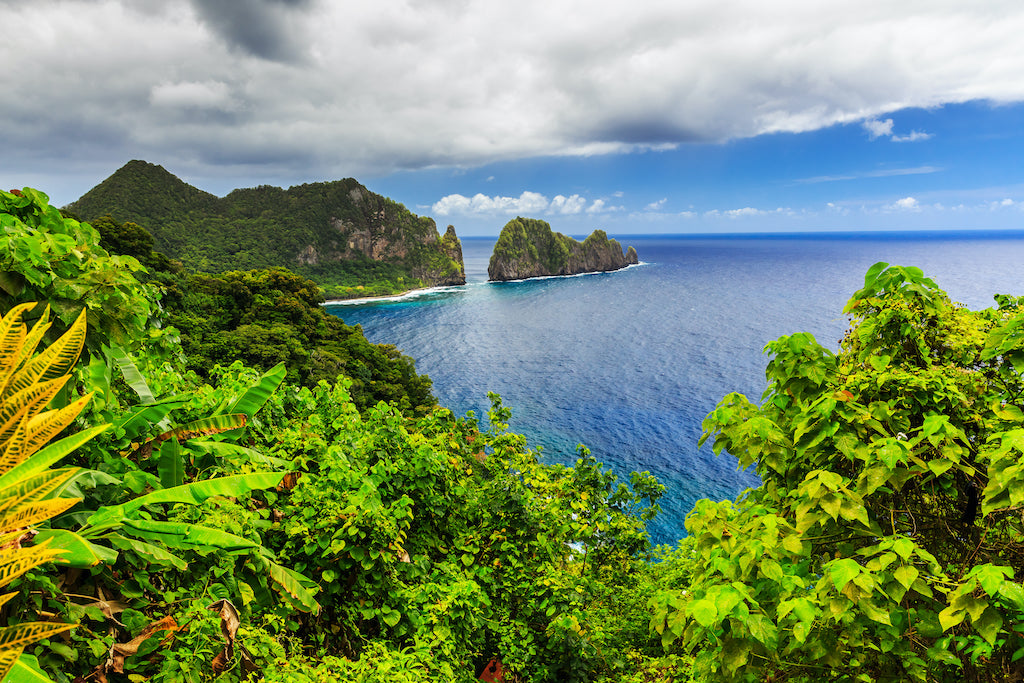Where is the National Park of American Samoa?
- GPS: Latitude: -14.2583 Longitude: -170.6833.
- Mailing Address:
National Park of American Samoa
MHJ Building, 2nd Floor
Pago Pago, AS 96799
The National Park of American Samoa sets itself apart from other American national parks by being the only one south of the equator. Located in the American Samoa, a remote U.S. territory in the tropical South Pacific Ocean, it is 2,566 miles south of Hawaii and just over 2,100 miles north of New Zealand. Hawaii is the closet U.S. landmass and only flights that go through Honolulu can reach the park. Papua New Guinea is about 5,000 miles east of the park.
How Big is the National Park of American Samoa?
The park covers three islands, Ofu, Ta’u, and Tutuila and is comprised of over 13,500 acres. A large portion of that acreage consists of coral reefs surrounded by ocean, amounting to 4,500 acres of the park being covered in water and coral. 10 villages participate in an agreement with the park, with some participating in subsistence farming on the land. The total area of the park equates to just over 14 square miles, and in 2002, Congress approved a 30% expansion of the park which entered Olosega Island.

The National Park of American Samoa Weather
The weather in the park is tropical, which means year-round, temperatures stay warm and humid with abundant amounts of rain. Average temperatures do not vary much from month to month, with the biggest different in high temperatures throughout the year amounting to only a four-degree difference.
This lack of temperature difference is evident through an average of 84 (January through April) and the “coolest” high temperature being 80 in July. The lowest average temperature at any point in the year tends to be 72 in July, which is winter in the Southern Hemisphere.
Rainfall amounts vary by elevation, with the lower areas receiving an average of 125 inches while some of the mountains can experience as much as 300 inches of rainfall a year! That’s 25 feet of rain in just twelve months or an average of just over two feet of rain every month.
When Did American Samoa Become a National Park?
In the early 1980s, the park became the forefront of legislation protecting the flying fox (also known as fruit bats). The Bat Preservers Association requested that Delegate Fofó Iosefa Fiti Sunia propose a bill that would help to keep the species’ natural habitat from being disrupted. The bill was passed, and the area included in the Federal Fish and Wildlife Restoration Act, which eventually led to the official creation of the US National Park of American Samoa on October 31, 1988.
It wasn’t until a few years later that the park service entered an agreement with eight local villages (later, two others joined), and the park was then able to lease the land for public use.
Things to Do in the National Park of American Samoa
Below, our National Park Visitors Guide highlights some of the fun activities and adventures this national park has to offer.
Homestay Program
Visitors can help to support the local economy by participating in a homestay program while visiting. This option provides the opportunity to stay with a local family and participate in cultural exchange.
Fruit Bat Sightings
Known alternately as flying foxes, fruit bats are one of the park’s most renowned animals. Their wingspan can reach up to three feet wide, and these animals are both nocturnal and active in the daytime.
Birdwatching
The park has 35 species of birds including both native birds and migratory ones. Birds like the bristle-thighed curlews fly all the way down from Alaska to winter in the warm temperatures of the park. Sea birds also use the area as a breeding for populations of terns and shearwaters.
View Fine Mats
Known as ‘ie toga in Samoan, fine mats are an important part of the area’s culture. During your stay, you can learn more about how Samoan culture is reflected in these mats that are traditionally given at weddings and funerals. Made only by women, these mats can take up to several years to create.

Hiking
The National Park of American Samoa has ten different hiking trails visitors can enjoy. Some of the trails can be difficult to get to from one another, so be prepared to have to take transportation if you intend to hike several of them.
Visitor Center
A second visitor center was built after the original was destroyed in the 2009 tsunami that hit the island. This center contains interactive exhibits for both children and adults and teaches visitors about the wildlife that inhabits the islands.
Fa'asamoa
Fa’asamoa is a word that represents Samoan culture and traditions. As a visitor to the park, take the opportunity to learn more about the culture of the area. Some particular points visitors will want to be aware of include recognizing that villagers may not allow for swimming and certain other activities on Sundays and observing a quiet evening prayer time called Sa.
Foods
Use your visit as an opportunity to learn more about the rich food culture that is present on the island. Coconuts are one food item that has seen extended use in the Samoan culture. Besides offering traditional beverage possibilities like coconut cream, the coconut has many other uses. Take notice of the fale (houses) which are bound with coconut husk fibers.
Fale
These are simple thatched huts are commonplace in Somoa. Visitors can rent a fale to help support a local family’s income. These open-air huts offer a simple sleeping accommodation so you can enjoy the beach but still have a roof-top covering.
Snorkeling
While there are no snorkeling rental options in the park, you can bring your own snorkeling gear to explore the waters off the island of Ofu, where over 950 different species of fish call home. Diving expeditions are available only on a charter basis.
When to Go to the National Park of American Samoa
As mentioned earlier, the temperatures in the park are stable enough to be enjoyed year-round. No matter what time of the year you visit, you will never have to worry about being too cold. Rainfall can be a deciding factor when planning your trip, as you may want to book in the dry season which typically extends from May through November. Tropical storms (including tropical cyclones) are common from end of November to early May. This period is referred to as the area’s rainy season.
Hotel rates typically stay about the same throughout the year, as only approximately 5,000 visitors make it to the park each year. Flights may vary around holiday time, so check the listings accordingly for the best prices.

Must-Have Things to Bring to the National Park of American Samoa
List of Parks wants you to be prepared for your adventures. We created a list of items you should consider bringing to the park.
Umbrella
With 300 inches of rainfall covering parts of the island, an umbrella is a must for any visitor. Rain showers are frequent so be prepared to encounter rain at any time.
Modest Clothing
For men and women alike, traditional Samoan culture emphasizes modesty. Be sure to bring modest clothing, including swimwear that covers up more than traditional swimming trunks and bikinis, in order to prevent offense.
Waterproof Maps
A waterproof map of the area is a good object to have on hand. Cell phone service can be spotty, and water from the occasional downpour can ruin a phone. Keep a copy of your map with you to prevent you from getting lost.
Flip Flops
With the sandy beaches, you can never go wrong with bringing a pair of flip flops. These classic beach sandals are lightweight so they’re easy to throw into a tote bag when you decide to go swimming in the beautiful waters of the park.
Cash
You will want to make sure you have small amounts of cash on hand for traveling. For example, some boats may cost a couple of dollars to take you from one island to another, while hiring a local taxi can also cost you money.
Binoculars
You’ll want a pair of quality binoculars to carry with you at all times so that you can get up-close views of wildlife like the famous flying fox and the various types of geckos that call the park home.
Plastic Bags
Carry a plastic bag with you throughout your visit so that you can always make sure to have a place to store your trash. As the park encompasses several villages, always make sure you respect the land and dispose of trash properly.
Snacks
Sometimes the transportation in the park can be hit or miss. Bringing snacks to have on hand if your stay gets extended by a few hours can make a huge difference in your enjoyment of the trip. Bringing high protein foods like almonds and jerky for a long-lasting energy boost.
Water
Always keep a refillable bottle of water on hand. With such high temperatures and levels of humidity, plan on sweating. A lot. Bringing a bottle of water with you wherever you go will help decrease your risk of getting dehydrated and having to call quits on your day out.
Sunglasses
Like with any higher elevations, the mountains of the island can provide you with more sun exposure than you would get while under the tree line. Bring a pair of quality sunglasses to protect your eyes from sun damage.

Where to Stay in the National Park of American Samoa
While there are hotels available in the park, there are two ways to get an immersive cultural experience. One way is to participate in the park’s Homestay Program, which gives visitors the chance to stay with a Samoan family. There is a form that needs to be filled out and sent via e-mail to the park service, so visit the National Park Service site for the most up-to-date details. You can also rent out a fale, which is a traditional Samoan structure. Renting these from a Samoan family can help to supplement their income while giving you the chance to sleep under the stars.
Food Near the National Park of American Samoa
The main island, Tutuila, is by far your best bet for procuring food. This area has restaurants offering local food while also familiar fast-food standbys. Grocery and convenience stores are sprinkled around the island as well, so you can always purchase groceries and prepare meals at your overnight accommodations. Be aware that the other islands have no restaurants at all, and a very small selection of stores.
Airports Near the National Park of American Samoa
The only way for visitors from the continental United States to visit the park is to take a flight to Honolulu, and then catch a smaller airplane from Hawaii to Pago Pago International Airport, which is located on Tutuila. The only flights leaving Honolulu are currently Hawaiian Airlines flights. The duration of the trip is around five hours and 40 minutes.

